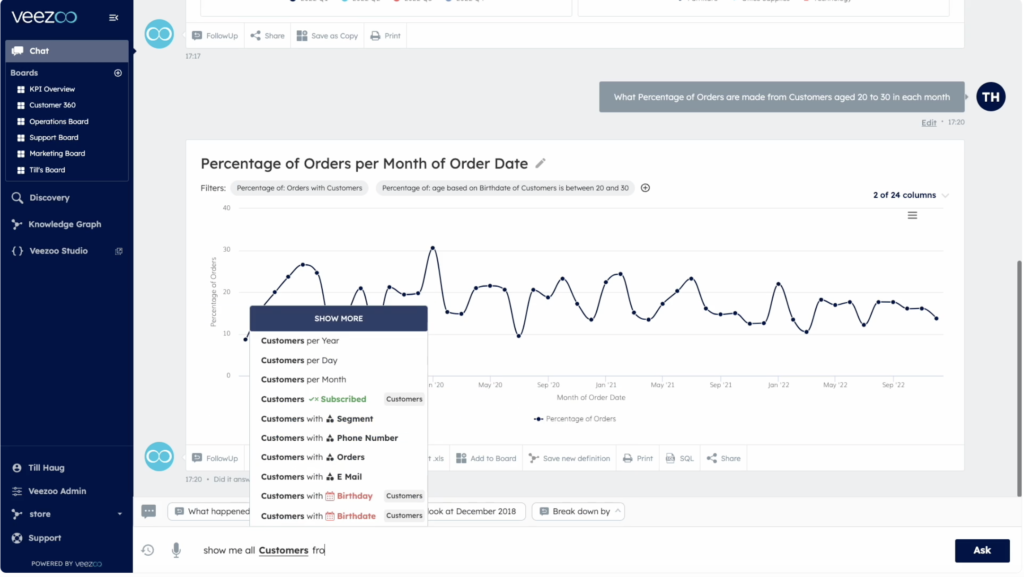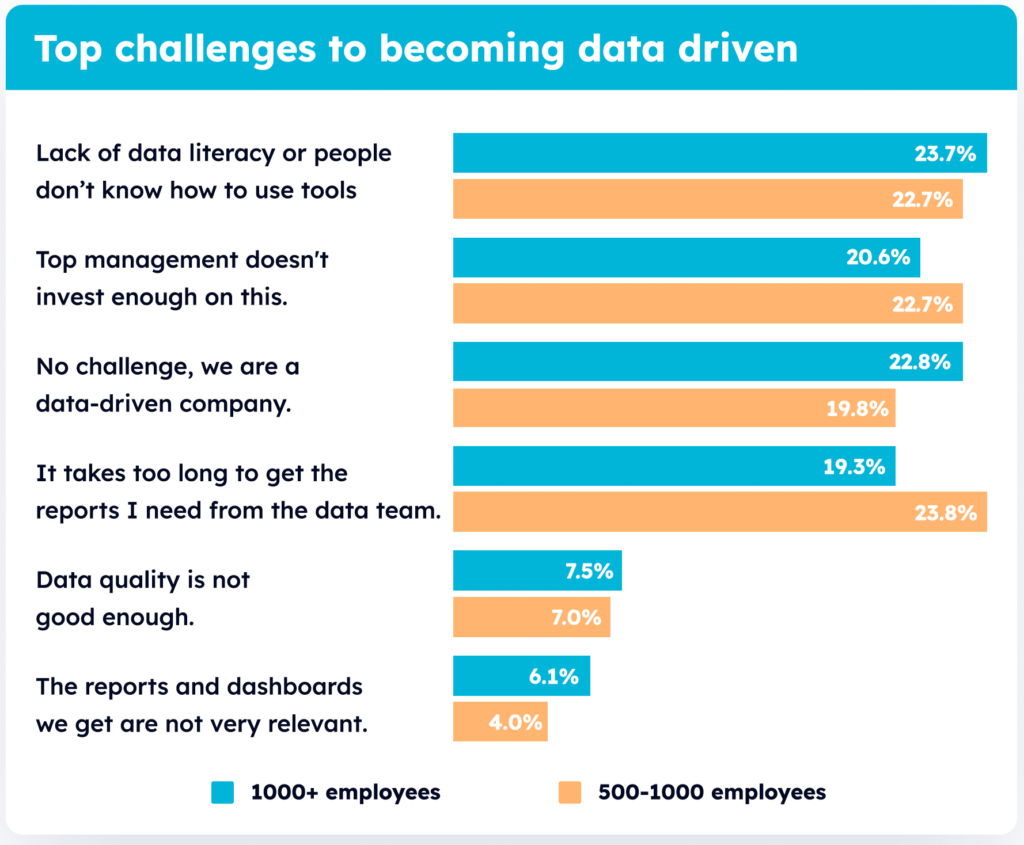How Self-Service Analytics Redefines the Way Teams Work with Data
In today's world, data takes center stage, driving strategies, influencing outcomes. Self-Service Analytics tools makes this possible, ensuring that everyone can extract insights from data - let's look at how.

Not too long ago, data was simply a “nice to have” when making business decisions.
This could be for several reasons, we didn’t have the right tools in place to leverage data, or even, the fact that we simply did not generate so much data that could help us extract insights.
Fast forward to today, and its prominence is undeniable. Data now takes center stage, driving strategies, influencing outcomes, and redefining competitive landscapes.
As businesses increasingly depend on data, its volume and complexity have surged proportionately. While its importance is universally acknowledged, effectively harnessing data poses unique challenges. Teams often encounter issues like disparate data sources, lack of technical skills to use the available data, and the overwhelming nature of vast information sources.
But one category of solution stands out amongst the clutter: Self-Service Analytics. Offering a solution for these challenges, these tools pave the way for comprehensive, yet uncomplicated data utilization. Simply because they create a self-serve experience, i.e. anybody can use them to extract insights.
How Business Teams Work with Data
Business teams analyze data, which forms the basis for informed decision-making. It is the process of extracting insights from data.
They use the analysis to formulate new projects and then monitor them. Monitoring is basically tracking KPIs in order to make sure that projects and tasks are being completed as per plan.
And finally, reporting condenses data into structured formats, presenting a snapshot of performance metrics.
Real-World Application: A digital marketing agency might generate monthly reports for a client, showcasing website traffic, engagement metrics, and conversion rates. Now based on these reports, they can analyze the kind of content that resonates with the target audience. Then, they would work on new pieces of content based on the analysis and monitor or track the response to these new pieces of content and finally, present these in monthly reports – and repeat the process.
So on the whole – the verdict is a straightforward one – working with data means people are able to make data-driven decisions which translate into better decisions.
But while business teams need to regularly work with data for these decisions, they also find it hard to do so. Working with data is a pretty complex process and requires many different parts to work together seamlessly.
Problems Faced When Working with Data
While data really has changed the way we make decisions today, it doesn’t come without its problems.
-
1. Complexity and Lack of Data Literacy

According to a recent survey we conducted, one of the top reasons for companies not being data-driven is a lack of data literacy. What does this actually mean?
Data literacy is the ability to interpret and draw conclusions from data. For example, what is the difference between qualitative and quantitative data? Or what is the difference between the median and the mode or even how far a certain metric has deviated from the median? Or whether the sample size is large enough to actually be indicative of the conclusions drawn.
Additionally, in most companies, a second barrier to becoming data literate is the use of complex BI tools which doesn’t encourage non-tech users to dig deeper.
How Self-Service Analytics Helps: While Self-Service Analytics can’t solve data literacy, it can help with the second barrier. What it does is expose business users to various use cases where they can easily access data. It also makes exploring data more playful which in itself becomes a learning experience. This encourages business users to find information on their own, interpret it, and help them make data-driven decisions.
Imagine a manufacturing firm trying to optimize its supply chain. Without a specialist, sifting through piles of procurement data, vendor histories, and shipment timelines can be overwhelming. This complexity often results in only a select few being able to tap into the data’s full potential, leaving a majority of the team in the dark. But this changes the moment there is a Self-Service Analytics solution. When this kind of solution is in the picture, business users such as customer-facing managers can dive into the data, find information on their own, and troubleshoot issues, providing quick answers to their clients.
-
2. Inconsistency and Integration Issues
Data doesn’t originate from a single source usually. It’s a combination of streams, each bringing its own format, metrics, and nuances.
How Self-Service Analytics Helps: Very few companies have a single source of truth for their data – usually they get information and data from various sources. The big problem then is to make the information from these sources match up – this can be a big task. While most of this falls within the realm of the data team, using a Self-Service Analytics tool that can display the different sources of data in a single screen could go a long way towards making it easier for business users.
Think of a multinational brand analyzing global customer feedback. Reviews might come from social media, direct emails, survey tools, and in-store feedback systems. The sheer diversity can introduce discrepancies, making it challenging to get a unified view and thus, compromising the integrity of insights.
-
3. Security and Compliance Challenges
In today’s digital realm, data is a treasure trove, and like any treasure, it attracts pirates. Ensuring its safety becomes paramount.
How Self-Service Analytics Helps: One of the bigger obstacles for data democratization is security. In simple terms, data teams want to ensure that only those who have the correct permissions get to see relevant data. However, with a Self-Service Analytics solution like Veezoo, this is taken care of. We ensure the highest levels of privacy and security – which means that people get to see only the data they have permission to access (based on role, business unit etc.)
It’s important to ensure that people only get access to information that is relevant to them.
Take, for instance, every organization that is GDPR compliant. A single breach could not only lead to a damaged reputation but also potentially, heavy fines. Ensuring compliance while managing data adds another layer of complexity.
How The Self-Serve Experience Changes the Overall Workflow
Our business landscapes today are full of data challenges, from maintaining clean data to safeguarding it. The problems described above are not exhaustive but Self-Service Analytics can help counter each of them.
Now let’s take a look at a higher-level scenario – what would a day look like if your team had access to a Self-Service Analytics solution?
Instead of being trapped in the maze of data complexity where only a handful with specialized training can decode valuable insights, teams are now empowered to delve directly into analytics.
Consider a scenario where a marketing team wants insights from last quarter’s sales data. Specifically, something like “The number of units of No Sugar Fanta sold to a specific demographic in California last quarter“.
Traditionally, this would mean liaising with data specialists, waiting for their bandwidth, and often going back and forth on nuances. With a Self-Service Analytics solution, the same team can directly ask questions, get real-time visual representations, and tweak their questions based on immediate insights.
What this means for the data analysts supporting this team is the fact that they can focus more on their core job. They can ensure that data quality is maintained and work on more strategic solutions, rather than spending their time answering ad-hoc requests that are usually urgent.
It also means that people no longer have to download Excel spreadsheets and send out data via email. The result is that they lose control over who gets to see it. But with a Self-Service Analytics solution, that has proper governance and permissions in place, you can ensure that people only see data that is relevant to them and also audit this.
This evolution, powered by Self-Service Analytics, doesn’t just simplify processes; it revolutionizes the very essence of data-driven decision-making in businesses.
Veezoo in Action
We’ve talked about how Self-Service Analytics solutions can help teams work better with data, but here’s a concrete example with Veezoo that helps bring this picture to light.
Let’s imagine you’re an e-commerce solution and want to dig deeper into the orders you received. We’ll show you exactly how you can do this with the video above:
All you have to do is ask and Veezoo will not only provide you with the answer but relevant visuals to help you make sense of it, like the video.
We ask:
What percentage of orders are made from customers aged 20-30 in each month?
And then we continue with:
Show me all customers from New York with no order in the last month?
You can also dig further into the data with Veezoo’s smart follow-up questions and really drill-down in order to identify a trend or a pattern. It really is that simple.
Insurance giant, Baloise, was looking for a way to make it easier to craft more targeted marketing campaigns – campaigns that would enable them to cross-sell or up-sell easily to existing customers. To solve this problem, Baloise chose to work with Veezoo because of its ease-of-use.

It was important to me to give our sales promoters a tool that enables them to develop ideas for needs-based campaigns for our customers. With Veezoo, they can make even complex queries down to contract level easily and quickly and validate ideas.
Today Baloise is able to craft more targeted campaigns and has experienced an increase in both its Up-Sells and Cross-Sells.
Wrapping Up
Data is vital in today's business world. But, working with it can be tough.
With Self-Service Analytics solutions, the process becomes simpler. Teams can easily access, understand, and use data without headaches. These tools make data problems easier to handle and decisions smarter. The future is clear: self-serve experiences are the way forward. Why wait? Get started and see the benefits for yourself.


